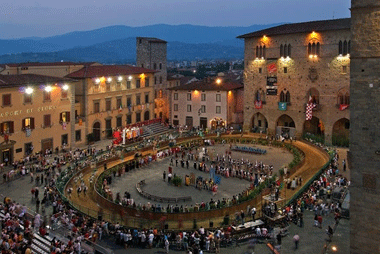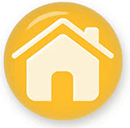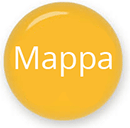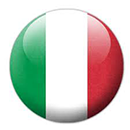The most ancient documentation of the 'Palio dei Barberi' (Palio of the Barbary horses) is from 1265. Many of the following documents talk about this special event which was organized in honour of Saint Jacopo.
The race was a great draw for a large number of people who came to Pistoia to see it. The horses were originally ridden by young riders, and then subsequently the horses were raced 'scossi' which means without a rider.
In the middle ages the race was run along a perfectly straight track, about three kilometres long, which followed the old line of the Cassia road. It started in Pontelungo, near to the Ombrone river, and came into the town along what is now Via Puccini, Via della Madonna, and Via degli Orafi. The race finished in Piazza Duomo directly in front of the church of 'Santa Maria Maggiore' (Saint Mary Major) on the right hand side of the city hall.
From the 16th century onwards, with the building of the new fortification at Porta Lucchese, the race moved away from its traditional route of 'corsa in lungo' (a long race) and into a more curved track that started from 'prato di San Francesco' (Saint Francis' field). Nowadays this of course is Piazza San Francesco which is also called 'luogo delle mosse' (place of the starting post). The route then proceeded down Via del Corso, which nowadays is divided into Corso Gramsci, Corso Fedi and Corso Amendola, and passed by Saint Vitale's crossroads and then Saint Paolo's crossroads. Finally, the horses arrived at the bottom of Corso Amendola where the medieval church of Santa Maria Nuova 'luogo della ripresa' (place of the revival). This church still exists in its original position, albeit in poor condition.
 The barbary horses were strong horses, with short, robust bodies and they were appreciated for their stamina in these difficult types of races. These animals belonged to the noble people of Pistoia, who loved to challenge each other to gain fame and to win valuable prizes. The run up to the race was always exciting and hectic. Before the start, the horses were left in a wide-open space where the most exciteable ones were divided by fences. The horses weren't allowed to have useless decorations or frills; the use of the 'perette' (small iron balls with nails or tips) which were used to spur the horses on, was permitted so that the horses could run faster. The knight of Podestà or the city commissary had to call the horses to the starting line, where the horses were taken blindfolded so as to protect them from the noise and excitement of the crowd. Then, at the call of 'alla corda Barbareschi' (to the rope Barbereschi), and when the trumpet sounded, the rope was dropped and the horses, like lightning, set off.
On the actual day of the Palio, Pistoia was always decorated for celebration. An opulent opening ceremony included a rich parade of foreigners and citizens through the streets of the town, where all the buildings were adorned with flags and coloured cloths. Pistoia was always full of people all trying to get into the best position to see the race.
The Palio lasted until 1858 when the City Council decided on its definitive cancellation. In 1947 the tradition of the Palio was re-born but its name had been changed to the current one, which is 'Giostra dell'Orso' (The Joust of the Bear), in honour of the animal which in Pistoia is called 'Micco' and is represented on the city symbol. The Joust, inspired by memories of the carnival of 1666, is completely different from the ancient Palio because it is a competition in which the riders have to challenge each other in their speed, ability and accuracy in hitting a bear shaped target. This celebration was held every year in Piazza Duomo until 1957, when it was again cancelled. It was however restarted in 1975, when the city council together with the four quarters of the city, Porta San Marco, Porta Lucchese, Porta al Borgo, and Porta Carratica decided to again run the competition in Piazza Duomo. This gave new life to the celebration of Saint Jacopo and to this day, enlivens the month of July in our city.
The barbary horses were strong horses, with short, robust bodies and they were appreciated for their stamina in these difficult types of races. These animals belonged to the noble people of Pistoia, who loved to challenge each other to gain fame and to win valuable prizes. The run up to the race was always exciting and hectic. Before the start, the horses were left in a wide-open space where the most exciteable ones were divided by fences. The horses weren't allowed to have useless decorations or frills; the use of the 'perette' (small iron balls with nails or tips) which were used to spur the horses on, was permitted so that the horses could run faster. The knight of Podestà or the city commissary had to call the horses to the starting line, where the horses were taken blindfolded so as to protect them from the noise and excitement of the crowd. Then, at the call of 'alla corda Barbareschi' (to the rope Barbereschi), and when the trumpet sounded, the rope was dropped and the horses, like lightning, set off.
On the actual day of the Palio, Pistoia was always decorated for celebration. An opulent opening ceremony included a rich parade of foreigners and citizens through the streets of the town, where all the buildings were adorned with flags and coloured cloths. Pistoia was always full of people all trying to get into the best position to see the race.
The Palio lasted until 1858 when the City Council decided on its definitive cancellation. In 1947 the tradition of the Palio was re-born but its name had been changed to the current one, which is 'Giostra dell'Orso' (The Joust of the Bear), in honour of the animal which in Pistoia is called 'Micco' and is represented on the city symbol. The Joust, inspired by memories of the carnival of 1666, is completely different from the ancient Palio because it is a competition in which the riders have to challenge each other in their speed, ability and accuracy in hitting a bear shaped target. This celebration was held every year in Piazza Duomo until 1957, when it was again cancelled. It was however restarted in 1975, when the city council together with the four quarters of the city, Porta San Marco, Porta Lucchese, Porta al Borgo, and Porta Carratica decided to again run the competition in Piazza Duomo. This gave new life to the celebration of Saint Jacopo and to this day, enlivens the month of July in our city.
 The barbary horses were strong horses, with short, robust bodies and they were appreciated for their stamina in these difficult types of races. These animals belonged to the noble people of Pistoia, who loved to challenge each other to gain fame and to win valuable prizes. The run up to the race was always exciting and hectic. Before the start, the horses were left in a wide-open space where the most exciteable ones were divided by fences. The horses weren't allowed to have useless decorations or frills; the use of the 'perette' (small iron balls with nails or tips) which were used to spur the horses on, was permitted so that the horses could run faster. The knight of Podestà or the city commissary had to call the horses to the starting line, where the horses were taken blindfolded so as to protect them from the noise and excitement of the crowd. Then, at the call of 'alla corda Barbareschi' (to the rope Barbereschi), and when the trumpet sounded, the rope was dropped and the horses, like lightning, set off.
On the actual day of the Palio, Pistoia was always decorated for celebration. An opulent opening ceremony included a rich parade of foreigners and citizens through the streets of the town, where all the buildings were adorned with flags and coloured cloths. Pistoia was always full of people all trying to get into the best position to see the race.
The Palio lasted until 1858 when the City Council decided on its definitive cancellation. In 1947 the tradition of the Palio was re-born but its name had been changed to the current one, which is 'Giostra dell'Orso' (The Joust of the Bear), in honour of the animal which in Pistoia is called 'Micco' and is represented on the city symbol. The Joust, inspired by memories of the carnival of 1666, is completely different from the ancient Palio because it is a competition in which the riders have to challenge each other in their speed, ability and accuracy in hitting a bear shaped target. This celebration was held every year in Piazza Duomo until 1957, when it was again cancelled. It was however restarted in 1975, when the city council together with the four quarters of the city, Porta San Marco, Porta Lucchese, Porta al Borgo, and Porta Carratica decided to again run the competition in Piazza Duomo. This gave new life to the celebration of Saint Jacopo and to this day, enlivens the month of July in our city.
The barbary horses were strong horses, with short, robust bodies and they were appreciated for their stamina in these difficult types of races. These animals belonged to the noble people of Pistoia, who loved to challenge each other to gain fame and to win valuable prizes. The run up to the race was always exciting and hectic. Before the start, the horses were left in a wide-open space where the most exciteable ones were divided by fences. The horses weren't allowed to have useless decorations or frills; the use of the 'perette' (small iron balls with nails or tips) which were used to spur the horses on, was permitted so that the horses could run faster. The knight of Podestà or the city commissary had to call the horses to the starting line, where the horses were taken blindfolded so as to protect them from the noise and excitement of the crowd. Then, at the call of 'alla corda Barbareschi' (to the rope Barbereschi), and when the trumpet sounded, the rope was dropped and the horses, like lightning, set off.
On the actual day of the Palio, Pistoia was always decorated for celebration. An opulent opening ceremony included a rich parade of foreigners and citizens through the streets of the town, where all the buildings were adorned with flags and coloured cloths. Pistoia was always full of people all trying to get into the best position to see the race.
The Palio lasted until 1858 when the City Council decided on its definitive cancellation. In 1947 the tradition of the Palio was re-born but its name had been changed to the current one, which is 'Giostra dell'Orso' (The Joust of the Bear), in honour of the animal which in Pistoia is called 'Micco' and is represented on the city symbol. The Joust, inspired by memories of the carnival of 1666, is completely different from the ancient Palio because it is a competition in which the riders have to challenge each other in their speed, ability and accuracy in hitting a bear shaped target. This celebration was held every year in Piazza Duomo until 1957, when it was again cancelled. It was however restarted in 1975, when the city council together with the four quarters of the city, Porta San Marco, Porta Lucchese, Porta al Borgo, and Porta Carratica decided to again run the competition in Piazza Duomo. This gave new life to the celebration of Saint Jacopo and to this day, enlivens the month of July in our city.


